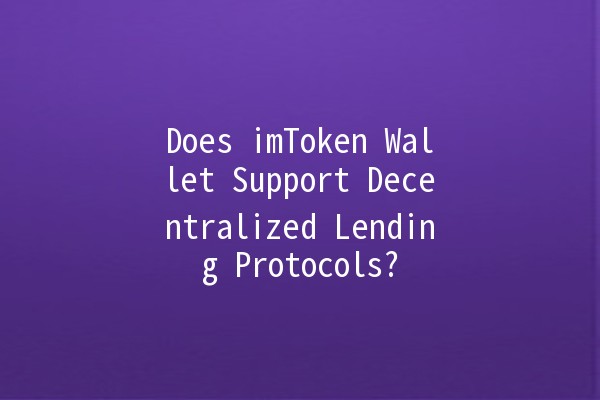The rise of decentralized finance (DeFi) has transformed the way people manage their digital assets. Among the various DeFi projects, decentralized lending protocols have gained significant traction, allowing users to lend and borrow cryptocurrencies without traditional financial intermediaries. As an increasingly popular cryptocurrency wallet, imToken has piqued the interest of many users regarding its compatibility with decentralized lending protocols. This article delves into whether imToken supports such protocols, the mechanics behind them, and practical insights that can enhance your experience in navigating the DeFi landscape.
imToken is a mobile cryptocurrency wallet that supports multiple blockchain networks, including Ethereum and various ERC20 tokens. With an intuitive user interface, it provides users with a secure environment to manage their digital assets, trade cryptocurrencies, and interact with decentralized applications (dApps). One of the significant features of imToken is its builtin Web3 browser, which allows users to explore and connect with various dApps, including those related to lending and borrowing.
Decentralized lending protocols are platforms that enable users to lend their cryptocurrencies and earn interest or borrow assets through smart contracts. Unlike traditional lending systems, these protocols operate without a central authority, relying instead on the blockchain for transparency and security. Some wellknown decentralized lending protocols include Aave, Compound, and MakerDAO.

As of now, imToken does not have builtin features specific for lending and borrowing within the application itself. However, it does provide users with the means to connect to various decentralized lending protocols through its Web3 browser. Below are some protocols that can be accessed through imToken:
Aave is one of the most popular decentralized lending protocols. Through imToken, users can navigate to the Aave dApp to deposit or borrow cryptocurrencies. When users deposit assets, they receive aTokens, which accrue interest over time. Conversely, to borrow crypto, users must deposit collateral, and interest rates will depend on the available liquidity.
Similar to Aave, Compound enables users to lend and borrow assets through its algorithmically governed protocol. Users can manage their Compound account through imToken's Web3 browser, allowing them to interact with the protocol while maintaining control over their private keys.
MakerDAO allows users to create stablecoins (DAI) by locking up collateral in smart contracts. Users can access MakerDAO’s services through imToken and participate in generating DAI while utilizing their cryptocurrency holdings as collateral.
To maximize the benefits of using imToken for interacting with decentralized lending protocols, consider the following productivityenhancing tips:
Keeping up with the latest trends and updates in the DeFi space is vital. Many platforms frequently update their features, and rates can change rapidly. Subscribe to DeFifocused newsletters or follow top influencers in the space on social media to stay informed.
Example: Check platforms like DeFi Pulse or Twitter for the latest insights.
While imToken provides robust security features, it is essential to follow best practices. Enable twofactor authentication, keep your seed phrase secure, and only interact with verified dApps.
Example: Regularly update app permissions and ensure you are interacting with legitimate URLs.
Before engaging with any lending protocol, perform a risk assessment. Consider factors such as market volatility and collateralization rates. Use online calculators to estimate potential returns and ensure that you are comfortable with the level of risk you are taking on.
Example: Tools like DeFi Rate allow you to compare interest rates across various platforms.
Just as in traditional finance, diversification can mitigate risks in DeFi. Consider lending a portion of your assets across multiple protocols instead of concentrating all your investments in one.
Example: If you have 1 ETH, consider lending 0.5 ETH on Aave, 0.3 ETH on Compound, and holding 0.2 ETH for future purposes.
The DeFi community is engaged, and platforms like Reddit or Telegram often have discussions about ongoing projects, potential pitfalls, or useful strategies. Engaging in these communities can provide insights and advice from experienced users.
Example: Join the r/DeFi subreddit for wider discussions about DeFi developments.
Engaging with decentralized lending protocols carries inherent risks, including price volatility, smart contract vulnerabilities, and potential loss of collateral. Users must carefully assess these risks before participating in lending or borrowing activities.
Collateralization in decentralized lending requires borrowers to lock up collateral—usually in a cryptocurrency form—before securing a loan. This ensures that lenders have a safeguard in case the borrower defaults, as they can claim the collateral to cover losses.
While you cannot earn interest directly through imToken, you can lend your assets via decentralized lending protocols accessed through the imToken Web3 browser, allowing you to earn returns on locked assets.
These are interestbearing tokens issued by lending protocols like Aave and Compound, respectively. When you lend assets, you receive aTokens or cTokens in return, representing your stake in the liquidity pool along with accrued interest.
Most decentralized lending platforms provide dashboards for tracking your lending activities, collateralization ratios, and earned interest. You can access this information through your imToken wallet by connecting to the respective dApp.
While transactions on the blockchain are pseudonymous, the level of privacy can vary. It's crucial to understand the privacy features of the specific lending protocol you use and to consider additional privacy tools if confidentiality is a concern.
In the growing world of DeFi, imToken wallet users have the opportunity to engage with various lending protocols through the application’s Web3 capabilities. By following the insights provided in this article, users can navigate the complex terrain of decentralized finance with greater confidence and security. Stay curious, informed, and ensure your investments align with your financial goals!